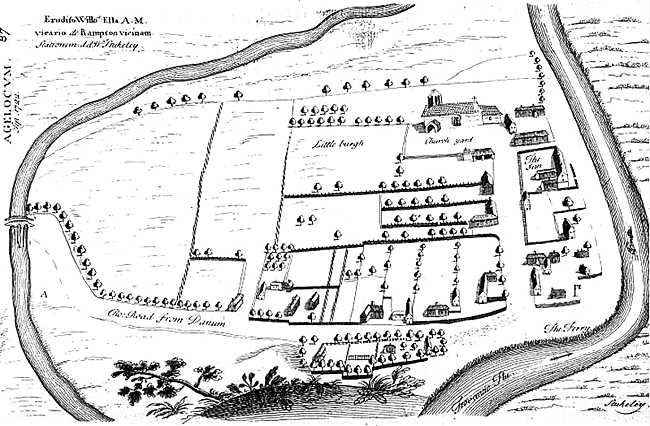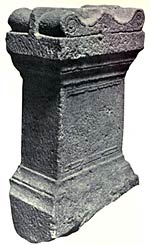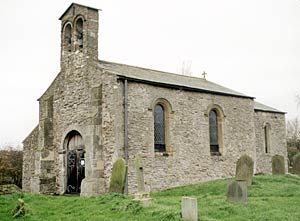< Previous | Contents | Next >
A Roman Lady Turns to Dust
LITTLEBOROUGH. In this tiny village, looking across the fine sweep of the Trent to Lincolnshire's green fields and wooded hills, there may still be old folk who remember a solemn sight once seen in the churchyard.

William Stukely's map of Littleborough (1724).

Roman altar found in the River Trent at Littleborough.
Where the Normans built the church the Romans had been before them, for here they brought their road from Lincoln to Doncaster across the river, and founded their station known as Segelocum. Altars, urns, pottery, and coins have been found and one discovery here is famous. In 1860, while digging a grave, the sexton came upon a stone coffin, and on the raising of the lid there was revealed the perfect body of a young woman, wearing a garment fastened by a Roman brooch. It was a dramatic spectacle of a moment, for in the twinkling of an eye this Roman lady crumbled into dust.
The time moves on two generations, and in the summer of 1933, when a great drought brought the river to a very low level, there was revealed the ford made here in the time of Hadrian. For many years it carried traffic between the north and south. Here Harold and his Saxons crossed on their way to Hastings. Here, while Harold lay in his grave at Waltham Abbey, the Conqueror himself may have come on his way from York to capture Lincoln.
The famous old highroad is quiet now. The Till Bridge Lane (as it is known on the Lincolnshire side) is only a grassy track, for the ferry (said to be the oldest in the land and to have been used since Roman days without a break) is almost abandoned. But still there is something important about the river here, for under it lie the trunk telegraph cables carrying our communications between north and south. Here, too, the Trent has a natural interest, for its waters rise and fall as the tides ebb and flow; and at the spring tides it experiences something of the famous Aegir, which rushes up the river at Gainsborough like a six-feet wall of water, caused by the meeting of the incoming tide and the downward rush of the river in its narrow channel.

Littleborough church in 2001.
A lofty elm and a sycamore shade the small lychgate into the churchyard. The quaint Norman church, with a bell turret, is one of the smallest in the county, with a chancel barely 13 feet long and a nave only 24. The walls have an abundance of herringbone masonry inside and out, and rarer still are the Roman tiles built into them.
We come into the nave through a lofty Norman doorway, and into the chancel by a recessed Norman arch on carved capitals crowning detached pillars. The round Norman font has been altered so that it has now eight sides at the top. There is a medieval piscina, an Elizabethan chalice, and a carving of the last Supper.
